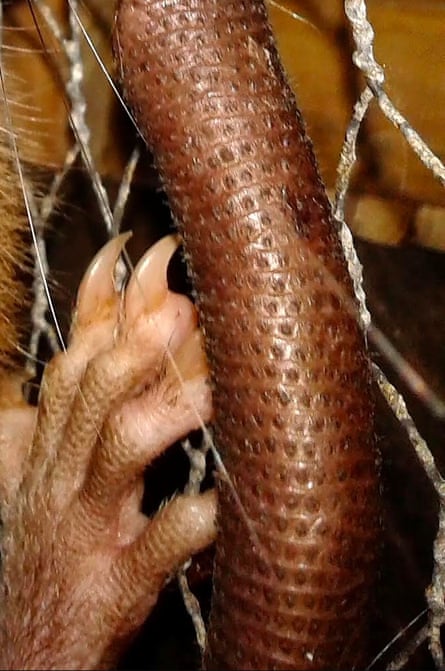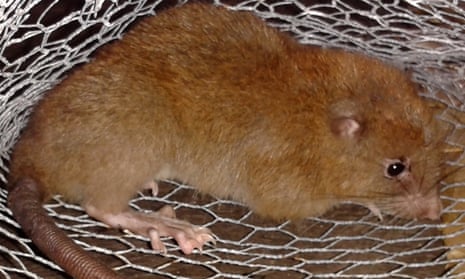A mysterious and elusive species of giant rat that lives in the dense rainforest canopy of the Solomon Islands, and is reputed to open coconuts with its teeth, has been discovered by scientists and is likely to be quickly listed as critically endangered.
For decades, the rat’s existence had been suspected, with traditional knowledge of the rat’s ecology noted in a publications. For example, in 1995, one account recorded traditional knowledge of “a very big rat that eats coconuts” and lived in the trees.
Tyrone Lavery, a mammalogist from the Field Museum in Chicago, heard rumours of the giant, possum-like rat on the island of Vangunu on his first trip to the Solomon Islands in 2010, which the locals called “vika”.
But extensive trappings, spotlight searches and motion-activated “camera traps” led by Lavery failed to reveal the storied rat. The only clue Lavery found of it was large rat faeces in 2011.
“I started to question if it really was a separate species, or if people were just calling regular black rats ‘vika’,” Lavery said.
But, in 2016, as a tree was cut down by commercial loggers, villagers who Lavery had been working with saw one fall to the ground, sustaining serious injuries. The rat died shortly afterwards but Lavery said the elders in the village of Zaira confidently identified the specimen as vika.

Careful study of the skull, as well as DNA analysis, confirmed it was a new species in the genus of “mosaic tailed rats” or Uromys, which Lavery named Uromys vika, after the traditional name for the rat.
The specimen they found, although missing some of its tail, was estimated to be over 45cm long and weighing more than half a kilogram.
Tim Flannery, a world-leading expert in the mammalogy of the Solomon Islands, told the Guardian it was an exciting and important discovery.
“It’s a remarkable new discovery of a mosaic tailed rat that found its way from either Australia or New Guinea several million years ago,” Flannery said. “It’s one of the most astonishing discoveries made in the new millennium and not a moment too soon. It’s highly endangered by logging and urgent action is required to prevent its extinction.”
Lavery said he had not found evidence of the rat eating coconuts but he had found evidence that they had eaten ngali nuts, a local nut that he said would be as hard to crack open as coconuts.
“If they could get through a ngail nut shell, they could get through a coconut,” he told the Guardian.
Lavery said he was driven to discover the rat through both a sense of adventure and a concern for conservation.
“I was excited because I had just started my PhD and I’d read a lot of books about people who go on adventures and discover new species,” Lavery said. “It’s a really interesting case. There’s traditional knowledge that it exists. And there’s old history notes from anthropologists and other people that have visited the island that these things exist.
“Secondly, it’s important to know they exist so that we can work out ways of conserving them. In the case of vika, it looks like logging is a really big threat to the species. There is not much of Vangunu left that hasn’t been logged.”
All sightings of the rat have been reported in kapuchu tree, including the captured specimen, which is highly sought after by commercial loggers. The total area of habitat that Lavery estimated the rat could potentially live in comprises just 81 square kilometres.
The paper describing the find, published in the journal Mammalogy, recommends it be listed an the category “critically endangered” by the IUCN.
Lavery said that right next to where the rat was found was a community conservation area run by a village called Zaira.
“We’re hoping that, now we’ve found this rat, it will add some recognition to their conservation area and help support them in their work.”
Lavery said he planned to launch a crowd-funding campaign to help the community build a station for the rangers that work in the conservation area.
